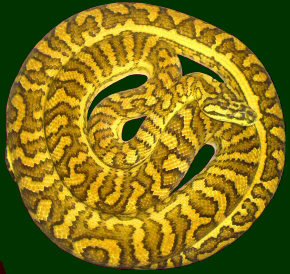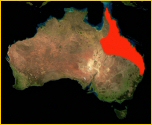

Description
 This is the largest of the carpet pythons with records of up to 14’ recorded. Most specimens are smaller however and average around 7’ in length. There is a correlation between size and distribution with the largest specimens originating in the southern portion of their range from the vicinity of Brisbane. Animals from further north are generally smaller in size.
This is the largest of the carpet pythons with records of up to 14’ recorded. Most specimens are smaller however and average around 7’ in length. There is a correlation between size and distribution with the largest specimens originating in the southern portion of their range from the vicinity of Brisbane. Animals from further north are generally smaller in size.
This is the most variable of all the  carpet pythons with regard to color and pattern characteristics. Coastal carpets are typically clad in various muted tones of gray and brown, but specimens with a myriad of appearances are well known, both from the wild and in captive collections.
carpet pythons with regard to color and pattern characteristics. Coastal carpets are typically clad in various muted tones of gray and brown, but specimens with a myriad of appearances are well known, both from the wild and in captive collections.
Animals from the southern portions of their range tend to hatch as red neonates and grow into large adults that lack a well-defined head pattern. Northern specimens of mcdowelli hatch as gray and black animals and generally have a well-defined head pattern.
Habitat
_thm.jpg) M.s.mcdowelli inhabits a variety of habitats within its range but is most often associated with heavily forested areas. Even large specimens are often observed in trees and there is a strong arboreal tendency with all carpet pythons. In the western portion of their range coastal carpets are strongly associated with the regions watercourses and other fragmented areas of more dense vegetation. This python is also a frequent visitor to both rural and sub-urban areas were they are encountered regularly.
M.s.mcdowelli inhabits a variety of habitats within its range but is most often associated with heavily forested areas. Even large specimens are often observed in trees and there is a strong arboreal tendency with all carpet pythons. In the western portion of their range coastal carpets are strongly associated with the regions watercourses and other fragmented areas of more dense vegetation. This python is also a frequent visitor to both rural and sub-urban areas were they are encountered regularly.
Distribution
 The coastal carpet python is native to much of the fertile eastern coast of Australia. In the south the distribution of M. s. mcdowelli extends as far as Coffs Harbour, New South Wales. This taxon ranges northward through the Cape York Peninsula. The western border of the coastal carpet pythons range is formed by the Great Dividing Range. This assembly of mountain ranges serves barrier, largely separating the coastal carpet python from the inland carpet python (M. s. metcalfei). In north-central Queensland the coastal carpet python’s distribution crosses the Great Dividing Range. The carpet pythons of the Cape York Peninsula are a highly variable and poorly understood group. Several authors have, at various times have attributed the specimens of this region to either: M. s. mcdowelli, M. s. variegata, M. s. cheynei, or some combination of these taxa. More study is warranted to properly interpret the nature of the carpet pythons residing on the Cape York Peninsula and their relationships.
The coastal carpet python is native to much of the fertile eastern coast of Australia. In the south the distribution of M. s. mcdowelli extends as far as Coffs Harbour, New South Wales. This taxon ranges northward through the Cape York Peninsula. The western border of the coastal carpet pythons range is formed by the Great Dividing Range. This assembly of mountain ranges serves barrier, largely separating the coastal carpet python from the inland carpet python (M. s. metcalfei). In north-central Queensland the coastal carpet python’s distribution crosses the Great Dividing Range. The carpet pythons of the Cape York Peninsula are a highly variable and poorly understood group. Several authors have, at various times have attributed the specimens of this region to either: M. s. mcdowelli, M. s. variegata, M. s. cheynei, or some combination of these taxa. More study is warranted to properly interpret the nature of the carpet pythons residing on the Cape York Peninsula and their relationships.
Projects
I am currently working with several distinct bloodlines of Coastal Carpet Python. Genetic diversity, proper research and background information are all critically important to me and my coastal carpet python collection reflects those goals. Because of the tremendous amount of carpet python hybrids and intergrades produced in recent years it has become difficult to locate pure specimens with any certainty. It took several years to locate and obtain the five bloodlines I currently work with but interested parties can have confidence that they are in fact pure mcdowelli.
I am working with two US bloodlines, the first of which we obtained circa 1993. The 16+ years I have been working with this line takes us back to a time prior to most of the hybrid problems we are plagued with today. These are great looking northern coastals with a typically pale base color.
The other US lineage I am working with has a long history tracing back twenty years. This bloodline has one of the longest histories of any in the US and I am aware of no other bloodline that can be traced back any further. This line of coastals produces outstanding offspring with a propensity for producing striped specimens.
In addition to the US bloodlines I have recently imported three new European lines of mcdowelli. This provides keepers with a rare opportunity to work with new and distinct genetic lineages. The first of these is a French bloodline. The animals we obtained from this line exhibit a kind of hypomelanism. These are the “caramel” line coastals seen in Europe. In addition to a new genetic mutation for the US they also represent a new lineage and an opportunity for keepers to add some diversity to our somewhat shallow gene pool.
The other two new bloodlines are perhaps the most special. I was very pleased to learn of two lineages being bred in Europe with locality information. One of these lines purportedly descends from region just north of Rockhampton QLD. These are very distinct coastals with a prominently banded appearance and all specimens have a unique head pattern not seen in any other lineage.
The other locality specific bloodline is believed to be from Brisbane QLD. These are the large red-phase animals. These animals are the largest of the coastal carpets, heavy bodied with large flat heads. This bloodline exhibits the characteristic reduced head pattern typically seen in this region.
I am currently also working with a few mutations such as striped/Tiger, Caramel and Jaguar.
